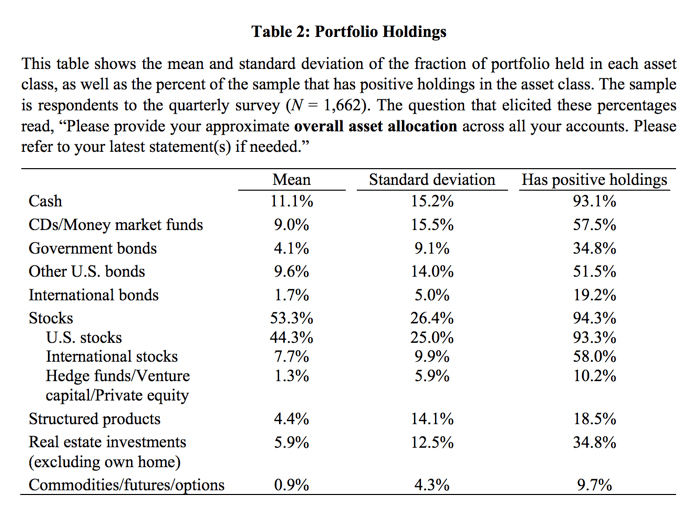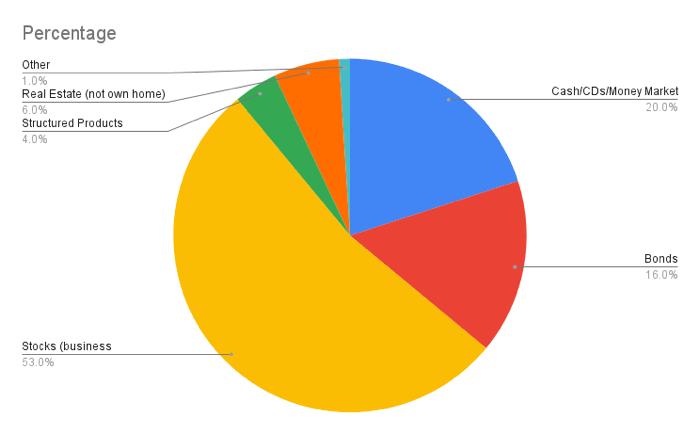The current issue of the Journal of Financial Economics has a new paper titled Millionaires speak: What drives their personal investment decisions? about how millionaires invest their money (via Alpha Architect):
We survey 2,484 U.S. individuals with at least $1 million of investable assets about how well leading academic theories describe their financial beliefs and personal investment decisions. The wealthy’s beliefs about financial markets and the economy are surprisingly similar to those of the average U.S. household, but the wealthy are less driven by discomfort with the market, financial constraints, and labor income considerations.
To be honest, I found most of the stated “beliefs” to be rather unsurprising. I’d rather just see what they actually own, which is revealed in this table:

I’ve gone ahead and simplified and rounded-off the averages above into a pie chart:

Over 1/3rd of the assets of millionaires are held in either cash, bonds, or the equivalent. The rich certainly have their riskier business ownership assets, but they also have a lot of cash. This is somewhat surprising since you’d think the rich wouldn’t need that much free cash lying around, but perhaps they feel that to stay a millionaire, you have to survive all the emergencies and liquidity crunches that inevitably occur from time to time.
 The Best Credit Card Bonus Offers – 2025
The Best Credit Card Bonus Offers – 2025 Big List of Free Stocks from Brokerage Apps
Big List of Free Stocks from Brokerage Apps Best Interest Rates on Cash - 2025
Best Interest Rates on Cash - 2025 Free Credit Scores x 3 + Free Credit Monitoring
Free Credit Scores x 3 + Free Credit Monitoring Best No Fee 0% APR Balance Transfer Offers
Best No Fee 0% APR Balance Transfer Offers Little-Known Cellular Data Plans That Can Save Big Money
Little-Known Cellular Data Plans That Can Save Big Money How To Haggle Your Cable or Direct TV Bill
How To Haggle Your Cable or Direct TV Bill Big List of Free Consumer Data Reports (Credit, Rent, Work)
Big List of Free Consumer Data Reports (Credit, Rent, Work)
The data would make more sense if it had any age information to it…
That is a good point.
I feel like we need terms to distinguish the types of “millionaires” – 1MM isn’t really that much money for retirement for a lot of the workforce working in higher COL areas (30k-50k 3-5% draw-down rate) – that’s not really enough to retire on at the same quality of life that got you to that first 1MM. Age is also, as Amy mentioned, a key factor in strategies. Most “millionaires” on the low end of that range I’d expect to be a very different group than millionaires on the higher end of the spectrum.
I think by the time you cross the 10MM threshold, the story would change drastically for a lot of people – that would be enough to retire comfortably at a high COL salary range even at safe withdraw levels. I could see a lot of people at that level choosing to put a big chunk into very safe allocations as a guarantee, since they would have enough to ride for quite a while on the cash and hope the stocks go up – but not sweat it at all if they don’t (e.g. at 10MM, 3MM = 100k/year for 30 years, PLUS the 7MM invested that you maybe don’t care about so much).
Basically, if you live in certain COL areas, 1MM isn’t that “rich” (yes, very privileged, but not “no real worries for life” rich). I think a LOT of people in that situation are looking at 1MM and stressing out – and making very different decisions than someone with 10MM+ or 100MM+ who hasn’t ridiculously over-extended themselves with lifestyle decisions.
Maybe I just don’t understand the point of view and lifestyles of the higher level millionaires, but it feels really out of touch to lump the whole range of 1MM-999MM into any sort of meaningful breakdown like this.
The original article did touch on that briefly:
> The surveys sample a total of 2484 U.S. respondents,
> each of whom has at least $1 million of investable assets,
> 18% of whom have at least $5 million, and 4% of whom have at least $10 million.
But then it’s hard to follow through the rest what the actual breakdowns were by asset group, unless I missed the table of data somewhere.
I personally sit on a lot of cash, but there are a few good reasons for this. First, getting wealthier has also caused me to increase my expenses. This is often called lifestyle inflation, it happens. Second, rather than having cash to preserve my wealth I have cash so that I have opportunities. Sitting on a big pile of cash not only feels good but when the right opportunities to invest in a good business comes up I can take it without doing too much to get the money on hand. It’s also about experience opportunities. If a friend calls on a whim and wants to fly to Japan to try some restaurant they read about, I can say “yes”. Cash is fun to have.